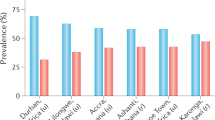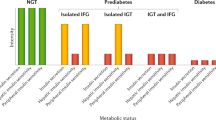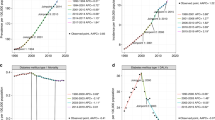Abstract
By the year 2030, >70% of people living with T2DM will reside in developing countries, and primary prevention of T2DM should be an urgent priority for such regions. The disease predominantly affects working-age persons and has a devastating economic impact, compounded by the frequent occurrence and interaction of T2DM with infectious diseases (such as AIDS and tuberculosis). Evidence from landmark T2DM prevention trials indicates that lifestyle modification is more effective, cheaper and safer than medication and provides sustained benefits. Lifestyle modification is, therefore, the most promising approach to T2DM prevention in developing countries; however, programmes adapted to their specific needs are lacking. Low-cost strategies to identify at-risk individuals, followed by the implementation of group-based, inexpensive lifestyle interventions, seem to be the best options for resource-poor countries. However, widespread implementation of T2DM prevention in developing countries will require coordinated efforts throughout society, along with comprehensive government policies and novel funding sources.
This is a preview of subscription content, access via your institution
Access options
Subscribe to this journal
Receive 12 print issues and online access
$209.00 per year
only $17.42 per issue
Buy this article
- Purchase on Springer Link
- Instant access to full article PDF
Prices may be subject to local taxes which are calculated during checkout
Similar content being viewed by others
Change history
01 October 2012
In the version of this article initially published in print and online there was a mistake saying small-molecule agents were used in preclinical studies The sentence should have read "preclinical studies have shown that a few adenovirus-delivered transcription factors could induce exocrine pancreatic cells to transdifferentiate into insulin-producing cells.39" The error has been corrected for the HTML and PDF versions of the article.
References
Kahn, S. E., Hull, R. L. & Utzschneider, K. M. Mechanisms linking obesity to insulin resistance and type 2 diabetes. Nature 444, 840–846 (2006).
Gerstein, H. C. et al. Annual incidence and relative risk of diabetes in people with various categories of dysglycemia: a systematic overview and meta-analysis of prospective studies. Diabetes Res. Clin. Pract. 78, 305–312 (2007).
Shaw, J. E., Sicree, R. A. & Zimmet, P. Z. Global estimates of the prevalence of diabetes for 2010 and 2030. Diabetes Res. Clin. Pract. 87, 4–14 (2010).
Danaei, G. et al. National, regional, and global trends in fasting plasma glucose and diabetes prevalence since 1980: systematic analysis of health examination surveys and epidemiological studies with 370 country-years and 2.7 million participants. Lancet 378, 31–40 (2011).
Alwan, A. et al. Monitoring and surveillance of chronic non-communicable diseases: progress and capacity in high-burden countries. Lancet 376, 1861–1868 (2010).
Zhang, P. et al. Global healthcare expenditure on diabetes for 2010 and 2030. Diabetes Res. Clin. Pract. 87, 293–301 (2010).
Yang, W. et al. Prevalence of diabetes among men and women in China. N. Engl. J. Med. 362, 1090–1101 (2010).
Barceló, A., Aedo, C., Rajpathak, S. & Robles, S. The cost of diabetes in Latin America and the Caribbean. Bull. World Health Organ. 81, 19–27 (2003).
Beran, D. & Yudkin, J. S. Diabetes care in sub-Saharan Africa. Lancet 368, 1689–1695 (2006).
Dagogo-Jack, S. Primary prevention of type 2 diabetes in developing countries. J. Natl Med. Assoc. 98, 415–419 (2006).
Ebrahim, S. et al. The effect of rural-to-urban migration on obesity and diabetes in India: a cross-sectional study. PLoS Med. 7, e1000268 (2010).
Ntandou, G., Delisle, H., Agueh, V. & Fayomi, B. Abdominal obesity explains the positive rural-urban gradient in the prevalence of the metabolic syndrome in Benin, West Africa. Nutr. Res. 29, 180–189 (2009).
Miranda, J. J., Gilman, R. H. & Smeeth, L. Differences in cardiovascular risk factors in rural, urban and rural-to-urban migrants in Peru. Heart 97, 787–796 (2011).
Teo, K., Chow, C. K., Vaz, M., Rangarajan, S. & Yusuf, S. The Prospective Urban Rural Epidemiology (PURE) study: examining the impact of societal influences on chronic noncommunicable diseases in low-, middle-, and high-income countries. Am. Heart J. 158, 1–7 e1 (2009).
Young, F., Critchley, J. A., Johnstone, L. K. & Unwin, N. C. A review of co-morbidity between infectious and chronic disease in Sub Saharan Africa: TB and diabetes mellitus, HIV and metabolic syndrome, and the impact of globalization. Global Health 5, 9 (2009).
Jeon, C. Y. & Murray, M. B. Diabetes mellitus increases the risk of active tuberculosis: a systematic review of 13 observational studies. PLoS Med. 5, e152 (2008).
Ratner, R. et al. Impact of intensive lifestyle and metformin therapy on cardiovascular disease risk factors in the diabetes prevention program. Diabetes Care 28, 888–894 (2005).
Dagogo-Jack, S., Egbuonu, N. & Edeoga, C. Principles and practice of nonpharmacological interventions to reduce cardiometabolic risk. Med. Princ. Pract. 19, 167–175 (2010).
Colagiuri, R., Short, R. & Buckley, A. The status of national diabetes programmes: A global survey of IDF member associations. Diabetes Res. Clin. Pract. 87, 137–142 (2010).
Pan, X. R. et al. Effects of diet and exercise in preventing NIDDM in people with impaired glucose tolerance. The Da Qing IGT and Diabetes Study. Diabetes Care 20, 537–544 (1997).
Tuomilehto, J. et al. Prevention of type 2 diabetes mellitus by changes in lifestyle among subjects with impaired glucose tolerance. N. Engl. J. Med. 344, 1343–1350 (2001).
Knowler, W. C. et al. Reduction in the incidence of type 2 diabetes with lifestyle intervention or metformin. N. Engl. J. Med. 346, 393–403 (2002).
Ramachandran, A. et al. The Indian Diabetes Prevention Programme shows that lifestyle modification and metformin prevent type 2 diabetes in Asian Indian subjects with impaired glucose tolerance (IDPP-1). Diabetologia 49, 289–297 (2006).
Nyenwe, E. A. & Dagogo-Jack, S. Metabolic syndrome, prediabetes and the science of primary prevention. Minerva Endocrinol. 36, 129–145 (2011).
Lindström, J. et al. Sustained reduction in the incidence of type 2 diabetes by lifestyle intervention: follow-up of the Finnish Diabetes Prevention Study. Lancet 368, 1673–1679 (2006).
Li, G. et al. The long-term effect of lifestyle interventions to prevent diabetes in the China Da Qing Diabetes Prevention Study: a 20-year follow-up study. Lancet 371, 1783–1789 (2008).
Knowler, W. C. et al. 10-year follow-up of diabetes incidence and weight loss in the Diabetes Prevention Program Outcomes Study. Lancet 374, 1677–1686 (2009).
[No authors listed] Effects of withdrawal from metformin on the development of diabetes in the diabetes prevention program. Diabetes Care 26, 977–980 (2003).
[No authors listed] Incidence of diabetes following ramipril or rosiglitazone withdrawal. Diabetes Care 34, 1265–1269 (2011).
Balagopal, P., Kamalamma, N., Patel, T. G. & Misra, R. A community-based diabetes prevention and management education program in a rural village in India. Diabetes Care 31, 1097–1104 (2008).
Oba, N., McCaffrey, R., Choonhapran, P., Chutug, P. & Rueangram, S. Development of a community participation program for diabetes mellitus prevention in a primary care unit, Thailand. Nurs. Health Sci. 13, 352–359 (2011).
Simmons, D., Rush, E. & Crook, N. Development and piloting of a community health worker-based intervention for the prevention of diabetes among New Zealand Maori in Te Wai o Rona: Diabetes Prevention Strategy. Public Health Nutr. 11, 1318–1325 (2008).
Weber, M. B., Ranjani, H., Meyers, G. C., Mohan, V. & Narayan, K. M. A model of translational research for diabetes prevention in low and middle-income countries: The Diabetes Community Lifestyle Improvement Program (D-CLIP) trial. Prim. Care Diabetes http://dx.doi.org/10.1016/j.pcd.2011.04.005.
US Department of Agriculture Center for Nutrition Policy and Promotion. Dietary Guidelines for Americans [online], (2011).
Ackermann, R. T., Finch, E. A., Brizendine, E., Zhou, H. & Marrero, D. G. Translating the Diabetes Prevention Program into the community. The DEPLOY Pilot Study. Am. J. Prev. Med. 35, 357–363 (2008).
Kiawi, E. et al. Knowledge, attitudes, and behavior relating to diabetes and its main risk factors among urban residents in Cameroon: a qualitative survey. Ethn. Dis. 16, 503–509 (2006).
Poterico, J. A., Stanojevic, S., Ruiz-Grosso, P., Bernabe-Ortiz, A. & Miranda, J. J. The association between socioeconomic status and obesity in Peruvian women. Obesity (Silver Spring) http://dx.doi.org/10.1038/oby.2011.288.
Hood, M. S., Little, J. P., Tarnopolsky, M. A., Myslik, F. & Gibala, M. J. Low-volume interval training improves muscle oxidative capacity in sedentary adults. Med. Sci. Sports Exerc. 43, 1849–1856 (2011).
Akinci, E., Banga, A., Greder, L. V., Dutton, J. R. & Slack, J. M. Reprogramming of pancreatic exocrine cells towards a β-cell character using Pdx1, Ngn3 and MafA. Biochem. J. 442, 539–550 (2012).
Wing, R. R. & Phelan, S. Long-term weight loss maintenance. Am. J. Clin. Nutr. 82 (Suppl.), 222S–225S (2005).
Ramachandran, A., Snehalatha, C., Yamuna, A., Mary, S. & Ping, Z. Cost-effectiveness of the interventions in the primary prevention of diabetes among Asian Indians: within-trial results of the Indian Diabetes Prevention Programme (IDPP). Diabetes Care 30, 2548–2552 (2007).
Acknowledgements
S. Dagogo-Jack's research is supported in part by grants from the NIH (DK67269, DK62203 and DK48411).
Author information
Authors and Affiliations
Contributions
Both authors contributed equally to researching information, discussion of content, writing and editing of the manuscript.
Corresponding author
Ethics declarations
Competing interests
The authors declare no competing financial interests.
Rights and permissions
About this article
Cite this article
Echouffo-Tcheugui, J., Dagogo-Jack, S. Preventing diabetes mellitus in developing countries. Nat Rev Endocrinol 8, 557–562 (2012). https://doi.org/10.1038/nrendo.2012.46
Published:
Issue Date:
DOI: https://doi.org/10.1038/nrendo.2012.46
This article is cited by
-
Effects of an isometric exercise training program on muscular strength, ankle mobility, and balance in patients with diabetic peripheral neuropathy in the lower legs in South Africa
International Journal of Diabetes in Developing Countries (2023)
-
Evaluation of skin lesions in diabetic patients: a systematic review and meta-analysis
Journal of Diabetes & Metabolic Disorders (2020)
-
Prevention begets prevention — lessons from the Da Qing Study
Nature Reviews Endocrinology (2019)
-
Correction: Preventing diabetes mellitus in developing countries
Nature Reviews Endocrinology (2012)



